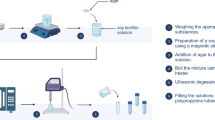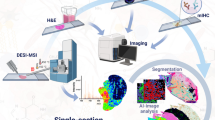Abstract
Laser-induced fluorescence has been used for the identification of brain tumours in rats, which have been previously given tumour-seeking haematoporphyrin derivative. A pulsed nitrogen laser (λ=337 nm) was used in conjunction with an optical multichannel analyzer. For both inoculated RG-2 and TCVC rat-brain-tumour models, the blue autofluorescence was strongly reduced in the tumour compared with normal brain tissue, and at the same time the characteristic red-drug signal increased. The contrast between tumour and normal tissue was strongly enhanced by forming the ratio between the two signals. Implications for possible improvement of tumour delineation in brain tumour surgery are discussed.
Similar content being viewed by others
References
Salford LG, Brun A, Nirfalk S. Ten years survival among patients with supertentorial astrocytoma grade III and IV.J Neurosurg 1988,69:506–9
Onoyama Y, Abe M, Sakamoto T et al. Radiation therapy in treatment of glioblastoma.Amer J. Roentgen 1976,126:481–92
Bell Jr B, Karnosh LJ. Cerebral hemisperectomi.J. Neurosurg 1949,6:685–93
Bigner DD, Pedersen HB, Bigner SH et al. A proposed basis for the therapeutical resistance of glioma.Semin Neurol 1981,1:169–79
Levin VA, Freeman-Dove M, Landahl HD. Permeability characteristics of brain adjacent to tumors in rats.Arch Neurol 1975,32:785–91
Moore GE, Peyton WT, French LA, Walker WW. The clinical use of fluorescein in neurosurgery.J. Neurosurg 1948,5:392–98
Wharen RE, Anderson RE, Laws ER. Quantitation of Hematoporphyrin Derivative in human gliomas, experimental central nervous systems tumors, and normal tissues.Neurosurg 1983,12:446–50
Boggan JE, Walter R, Edwards MSB et al. Distribution of hematoporphyrin derivative in the rat 9L gliosarcoma brain tumor analyzed by digital video fluorescence microscopy.J Neurosurg 1984,61:1113–9
Perria C, Capuzzo T, Cavagnaro G et al. First attempts at the photodynamic treatment of human gliomas.J Neurosurg Sci 1980,24:119–29
Laws ER, Cortese DA, Kinsey JH et al. Photoradiation therapy in the treatment of malignant brain tumors: a phase I (feasibility) study.Neurosurg 1981,9:672–8
McCulloch GAJ, Forbes IJ, Lee See K et al. Phototherapy in malignant brain tumors. In: Doiron DR, Gomer CJ (eds)Porphyrin Localization and Treatment of Tumors. New York: Alan R Liss 1984:709–17
Bown SG, Carruth JAS, Jori G, Svaasand LO (eds).International Conference on Photodynamic Therapy and Medical Applications, Laser Med Sci, Abstract Issue, July 1988
Ankerst J. Montán S, Svanberg K, Svanberg S. Laser-induced fluorescence studies of hematoporphyrin derivative (HpD) in normal and tumor tissue of rat.Appl Spectr 1984,38:890–6
Svanberg K, Kjellén E, Ankerst J et al. Fluorescence studies of hematoporphyrin derivative in normal and malignant rat tissue.Cancer Res 1986,46:3803–8
Andersson-Engels S, Ankerst J. Montán S et al. Aspects of tumour demarcation in rats by means of laser-induced fluorescence and haematoporphyrin derivatives.Lasers Med Sci 1988,3:239–48
Berenbaum MC, Hall GW, Hoyes AD. Cerebral photosensitisation by hematoporphyrin derivative. Evidence for an endothelial site of action.Br J Cancer 1986,53:81–9
Wise BL, Taxdal DR. Studies of the blood-brain barrier utilizing hematoporphyrin.Brain Res 1967,4:387–9
Svaasand LO, Ellingsen R. Optical properties of human brain.Photochem Photobiol 1983,38:293–9
Svaasand LO, Ellingsen R. Optical penetration in human intracranial tumors.Photochem Photobiol 1985,41:73–6
Druckrey H. Cancer induction by chemical substances. In: Schmidt CG, Wetter O (eds)Progress in Cancer Research. Molecular Biology, Growth, and Clinic. New York: Schattenauer 1969:37–65
Lee YS, Bigner SH, Eng LF et al. A glial fibrillary acidic protein-expressing and tumorigenic cell line derived from an Avian Sarcoma Virus-induced rat astrocytoma.J Neuropathol Exp Neurol 1986,45:704–20
Montán S, Svanberg K, Svanberg S. Multicolor imaging and contrast enhancement in cancer-tumor localization using laser-induced fluorescence in hematoporphyrin-derivative-bearing tissue.Optics Lett 1985,10:56–8
Andersson PS, Montán S, Svanberg S. Multi-spectral system for medical fluorescence imagining.IEEE J Quantum Electr 1987,QE-23:1798–805
Author information
Authors and Affiliations
Rights and permissions
About this article
Cite this article
Andersson-Engels, S., Brun, A., Kjellén, E. et al. Identification of brain tumours in rats using laser-induced fluorescence and haematoporphyrin derivative. Laser Med Sci 4, 241–249 (1989). https://doi.org/10.1007/BF02032454
Received:
Issue Date:
DOI: https://doi.org/10.1007/BF02032454




